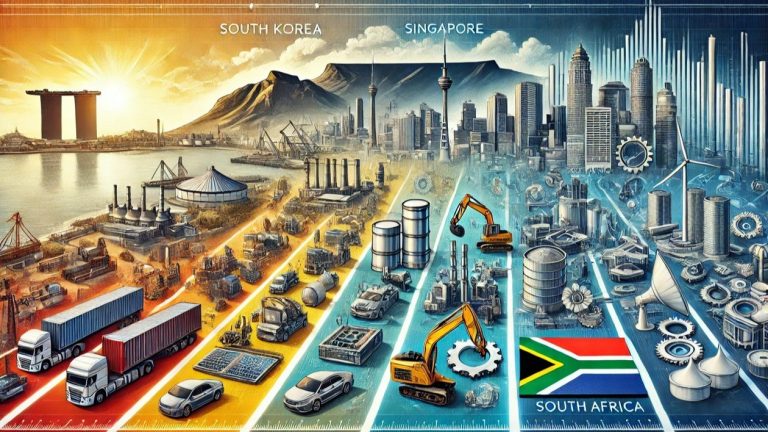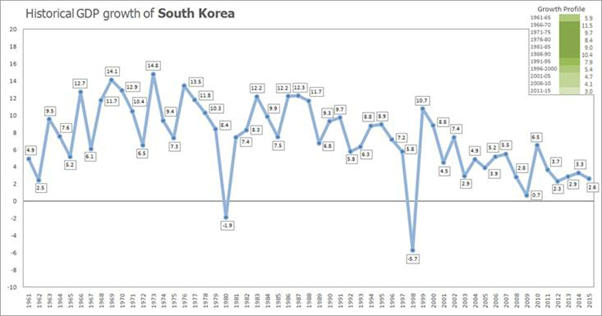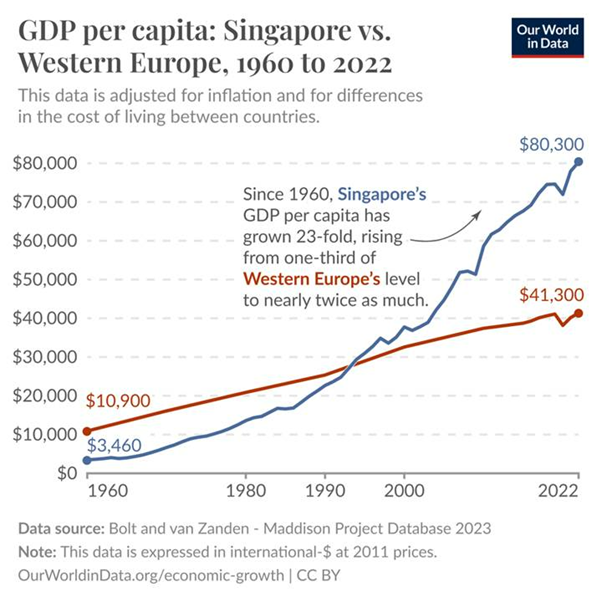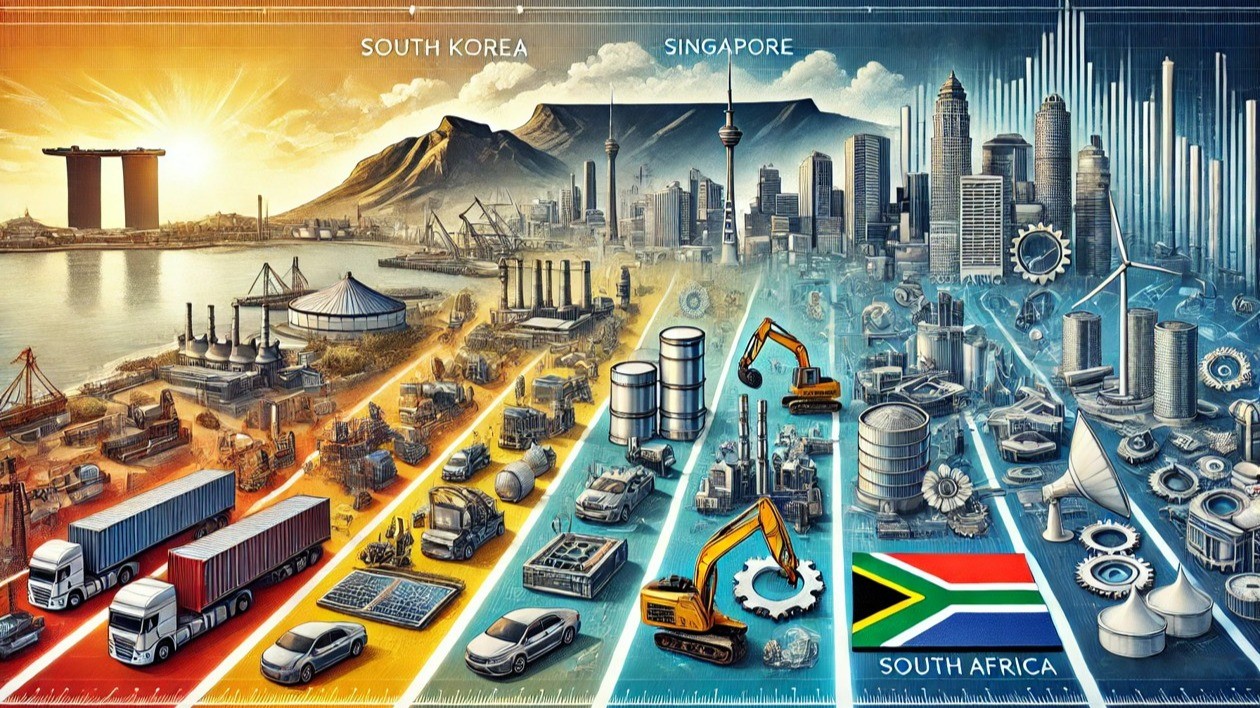Large-Scale Job Creation: Lessons from South Korea & Singapore
While South Africa continues to grapple with high unemployment, both South Korea and Singapore transitioned from low-income economies in the 1960s to high-income nations with near-full employment today. Their success wasn’t accidental.
Through targeted industrial policies, strategic government interventions, and a relentless focus on skills development, these nations built globally competitive industries that fuelled economic growth and employment.
Could South Africa replicate aspects of this approach?
The paper delves into:
- How South Korea’s chaebol-driven industrialisation (Hyundai, Samsung, LG) created millions of jobs.
- How Singapore’s foreign direct investment strategy transformed it into a global business hub.
- The relevance of these models to South Africa’s key industries—mining, manufacturing, and financial services.
- Policy recommendations, including export-oriented industrialisation, skills development, and infrastructure investment.
If South Korea could transition from an agrarian economy to a global manufacturing powerhouse, and Singapore could leverage its strategic location to drive industrial expansion, what’s stopping South Africa from redefining its economic trajectory?
Read the full paper to explore how South Africa can take decisive steps toward sustainable job creation.

Explore how South Korea and Singapore’s industrial policies led to job creation and how these strategies can be applied to South Africa’s primary industries.
Introduction
South Africa faces the challenge of high unemployment and a need for inclusive growth. In contrast, East Asian economies like South Korea and Singapore have achieved remarkable job-rich growth over recent decades. Notably, in 1965 Singapore’s GDP per capita was only about $500, roughly on par with South Africa at the time. Today, Singapore and South Korea are high-income countries with near full employment, whereas South Africa’s unemployment remains persistently high (about 31.9% overall and 44.6% for youth as of Q4 2024). This report analyses South Korea and Singapore’s large-scale job creation strategies, focusing on key industries and policies, and discusses how similar approaches could be relevant to South Africa’s primary industries that contribute most to its GDP. The report is organised into sections covering Industry Analysis, Policy Interventions, Employment Growth, and Recommendations for South Africa. Each section will highlight the economic transformations in South Korea and Singapore and extract insights applicable to South Africa’s context.
Industry Analysis


Figure:
South Korea’s annual GDP growth rates from 1961–2015
South Korea’s annual GDP growth rates from 1961–2015, illustrating its rapid industrialisation era (1960s–1990s) with growth often above 8% per year. This economic boom was driven by a shift from an agrarian economy to an export-focused industrial economy. The sustained high growth enabled massive expansion of manufacturing and related industries, laying the foundation for job creation on a broad scale. Notable downturns in 1980 and 1998 (visible as sharp dips) correspond to external shocks (oil crisis and Asian financial crisis), but the overall trend shows how quickly South Korea advanced during its “Miracle on the Han River” period.
South Korea’s Industrial Transformation:
In the early 1960s, South Korea was a low-income country heavily reliant on agriculture and raw materials. Over 80% of its labour force worked in agriculture around 1960, and the country had minimal industrial base. Starting in 1962, the government launched ambitious Five-Year Plans targeting industrial growth. South Korea adopted an export-oriented industrialisation strategy – it protected domestic industries while vigorously promoting exports. Key industries were developed almost from scratch: textiles and light manufacturing in the 1960s, followed by heavy industries (steel, shipbuilding, petrochemicals) and automobile manufacturing in the 1970s. Large family-owned conglomerates known as chaebols (e.g. Hyundai, Samsung, LG) were nurtured with state support to lead these sectors. By building industries such as steel production (POSCO), shipyards, and electronics, South Korea created a diversified industrial base. The manufacturing sector’s share of the economy more than doubled – from about 14% of GNP in 1962 to over 30% by the late 1980s – indicating a dramatic shift toward industry. This industrial transformation provided the backbone for large-scale employment in factories, construction, and related services as the economy urbanised.
Singapore’s Industrial Evolution:
Singapore, a small city-state with no natural resources, also underwent a rapid transition from a trade-post economy to an industrial and service hub. Upon independence in 1965, Singapore faced 14% unemployment and widespread poverty. To spur job creation, it pursued an export-led development strategy somewhat parallel to South Korea’s, but with a stronger emphasis on attracting foreign direct investment (FDI). The government established the Economic Development Board (EDB) in 1961 to develop industrial estates (such as Jurong Industrial Estate) and entice multinational corporations to set up factories. In the late 1960s, new factories in electronics assembly, textiles, ship repair, and petrochemicals proliferated. By the early 1970s, Singapore had built a solid manufacturing base – reaching full employment as early as 1972. In subsequent decades, Singapore continually upgraded its industry mix: moving from labour-intensive manufacturing in the 1960s–70s to technology-intensive industries (consumer electronics, semiconductors, pharmaceuticals) in the 1980s–90s, and then to high-value services (finance, logistics, biotechnology, digital tech) in the 2000s. Manufacturing and services became “twin pillars” of the economy. Today, about 20-25% of Singapore’s GDP comes from manufacturing (e.g. electronics, chemicals, precision engineering) and roughly 70% from services – a balance that reflects successful diversification. This broad-based industrial evolution created employment not only in factories, but also in supporting sectors like transportation, banking, and professional services.
Relevance to South Africa’s Industries:
South Africa’s economy, while the most industrialised in Africa, has a different profile. Services account for about 62.6% of GDP, industry 24.6%, and agriculture around 2.6%. The country’s primary industries include mining (the world’s largest producer of platinum and a major producer of gold and chromium), automotive manufacturing, steel and chemicals, and a strong financial services sector. Unlike South Korea, which lacked mineral wealth and thus focused on manufacturing exports, South Africa’s growth has historically been linked to its rich natural resources. And unlike city-state Singapore, which leveraged entrepôt trade and finance, South Africa has a larger domestic market and labour force to employ. The industrial experiences of South Korea and Singapore suggest that South Africa could benefit from diversifying and upgrading its industrial base. For example, moving up the value chain in mineral beneficiation (processing raw minerals into finished products) echoes South Korea’s approach to steel and shipbuilding, and Singapore’s success in oil refining and electronics manufacturing. Similarly, expanding manufacturing exports (such as vehicles, machinery, and processed goods) and developing high-value service industries (tourism, finance, ICT) could help absorb more labour. In sum, South Korea and Singapore demonstrate how strategic focus on key industries – even starting from different initial conditions – can transform an economy and create jobs. South Africa’s mix of mining, manufacturing, and services could be re-energised through similar strategic interventions tailored to its strengths.
Policy Interventions
Both South Korea and Singapore relied on active government policy interventions to catalyse industrial growth and employment. Their approaches combined state planning, investment in human capital, and pro-business reforms, albeit in different ways.
South Korea’s Policies:
The South Korean government took a hands-on role in economic development, especially from the 1960s through 1980s. Under President Park Chung-hee, the state formulated Five-Year Economic Plans that set targets for output, exports, and job creation in priority sectors. To implement these plans, the government intervened in financial markets – for instance, it nationalised banks in the 1960s to direct cheap credit into manufacturing and exports. Generous incentives were provided to firms that met export targets, including tax breaks, subsidised loans, and import duty exemptions on inputs. The government also actively courted foreign technology and expertise: it imported technology and know-how through licensing and by sending engineers abroad. In the 1970s, South Korea launched the Heavy and Chemical Industrialisation (HCI) initiative, pouring investment into steel mills, chemical plants, shipyards, and electronics facilities. This involved creating state-owned enterprises like POSCO (steel) and offering direct support to chaebols to venture into new industries. Labor policy initially favoured employers – South Korea in early decades had weak labour protection (no minimum wage or easy unionisation) to keep labour costs competitive. At the same time, enormous emphasis was placed on education and skills training. The government rapidly expanded secondary and technical education, ensuring a supply of literate, skilled workers for industry. By aligning education with industrial policy, South Korea equipped its workforce for the new jobs being created. In summary, the Korean state acted as a “developmental state”, coordinating investments, protecting nascent industries, and pushing firms to compete globally – a strategy that underpinned both GDP growth and job growth.
Singapore’s Policies:
Singapore’s approach was characterised by strategic state guidance of the economy combined with openness to foreign investment. From the outset, the government under Lee Kuan Yew emphasised macroeconomic stability, rule of law, and anti-corruption measures, making Singapore an attractive place to do business. The Economic Development Board served as a one-stop agency to plan industrial expansion, build infrastructure, and offer incentives to investors. Singapore did not rely on large domestic firms (it had few); instead, it offered multinational corporations tax holidays, grants, and infrastructure support to bring in capital and know-how. By the 2000s, foreign companies accounted for 75% of manufacturing output and 85% of manufactured exports from Singapore – a testament to its success in leveraging FDI for industrialisation. Alongside welcoming foreign investors, Singapore invested heavily in its people. The government funded universal education and later continuous skills upgrading programs (such as vocational institutes and the Skills Development Fund). Human capital development was seen as crucial given Singapore’s only resource was its labour force; leaders identified education as key to competing globally. Another policy pillar was infrastructure development: modern ports, airports, roads, power, and telecommunications were developed to world-class standards, directly enabling commerce and job growth. Singapore also practiced adaptive economic planning – when labour shortages emerged in the 1970s, it shifted policy to encourage higher value industries and automation; in the 1980s and 90s, it liberalised financial markets and grew as a finance hub. Institutions like the National Wages Council helped manage wage growth in line with productivity, ensuring labour cost competitiveness even as incomes rose. The government also entered joint ventures through government-linked companies (GLCs) in strategic sectors (e.g. shipping, airlines, semiconductors) to jumpstart those industries. In short, Singapore’s policy mix involved pro-business governance, targeted incentives for desired industries, investment in skills, and continuous economic restructuring to move up the value chain. This nimble and pragmatic approach created an environment in which businesses thrived, and jobs were plentiful.
Common and Differing Strategies:
While South Korea’s path relied more on fostering large domestic firms and Singapore’s on attracting foreign ones, both countries’ governments strategically targeted industrial growth as a means to create employment. Each had multi-year development plans that aligned public resources (budget, education, infrastructure) with their industrial goals. Both intervened to ensure the workforce had appropriate skills and both maintained generally business-friendly climates. A key difference was in labour and social policies: South Korea’s early growth was accompanied by authoritarian rule and suppressed labour activism, whereas Singapore implemented a kind of social compact (limited welfare but high investment in public housing, healthcare, and steady wage increases) that kept social stability. Despite these differences, the outcomes were similar – robust economic growth across diverse industries, fuelling high demand for labour. These policy interventions transformed the economic structure of each nation, as evident in the employment gains discussed next.
Employment Growth
Large-scale job creation was a direct result of the industrial and economic transformations in South Korea and Singapore. As factories, offices, and infrastructure projects took off, millions of people transitioned into new employment opportunities, drastically reducing unemployment in both countries.
In South Korea, the link between growth and jobs was very strong, especially during the high-growth era. The migration of labour from rural farming into urban industry was massive. In 1960, roughly 60% of Koreans worked in agriculture, but this fell to about 38% by 1980 as manufacturing and service jobs expanded. With the economy averaging 8–10% annual growth for decades, companies were hiring at unprecedented rates. By the late 1960s, the unemployment rate – which had been in double-digits in the early 60s – dropped to very low levels. In fact, since the end of the 1960s, South Korea’s unemployment has rarely exceeded 5% of the labour force. This effectively means the country approached full employment during its boom. As heavy industries (steel, autos, shipbuilding) grew in the 1970s, they absorbed vast numbers of technicians, engineers, and semi-skilled workers. For example, the shipyards in Ulsan and the automobile plants of Hyundai became major employers. The construction sector also boomed (building highways, ports, cities), providing jobs for many migrant workers from the countryside. Real wages in South Korea rose steadily as the demand for labour kept pace with supply; by the 1980s, workers were seeing significant improvements in income and job quality. The creation of a large middle class in South Korea by the late 20th century is tied to this employment expansion in manufacturing and later in white-collar professions. Even through ups and downs, South Korea’s employment grew alongside GDP – for instance, after the 1997 Asian financial crisis (when unemployment spiked temporarily), the economy rebounded and quickly re-absorbed workers in the early 2000s. Overall, South Korea’s experience shows that rapid industrial growth can translate into broad-based employment gains, moving a population from subsistence agriculture into modern jobs within a generation.
In Singapore, the effect of development on employment was even more immediately visible due to its small size. Singapore went from a labour-surplus economy in the 1960s to a labour-scarce economy by the 1970s. Between 1965 and 1973 – when GDP was growing over 10% per year – unemployment fell from 14% to virtually 0%. During this period, hundreds of new factories opened. One historical statistic highlights this surge: in the late 1960s, Singapore was adding tens of thousands of manufacturing jobs annually (one source notes that 147,500 manufacturing jobs were created between 1967 and 1973). By the early 1970s, employers actually faced worker shortages, prompting Singapore to begin allowing controlled immigration of foreign workers to fill low-skill jobs (a trend that continues today). As a result of reaching full employment, most Singaporeans who wanted work could find it, and household incomes rose rapidly. In the 1980s and 1990s, the nature of employment shifted towards higher-skilled jobs: the workforce gained more professionals in electronics, finance, and later, IT and biotechnology. However, throughout Singapore, unemployment was maintained to a low rate (typically 2–4% in normal years). Moreover, the quality of jobs improved over time – the state invested in productivity and encouraged firms to move up the skill ladder, so new jobs in the 1990s were often more skill-intensive (and higher paying) than the factory jobs of the 1960s. Singapore also managed to keep labour force participation high by bringing more women into the workforce over time and offering retraining programs for older workers. The net effect is a very robust labour market: as of 2024, Singapore’s employment rate for working-age adults is around 65–70%, comparable to advanced Western economies. The transformation from slums and joblessness in 1965 to a fully employed, predominantly middle-class society within a few decades underscores the scale of Singapore’s job creation success.

Figure:
Singapore’s GDP per capita (blue line) vs Western Europe (red line), 1960–2022, in constant international dollars.
This chart highlights Singapore’s dramatic rise in average income, which grew 23-fold since 1960, far outpacing Western Europe. Such income growth reflects not only economic output but also broad-based employment and productivity gains. Singapore’s rapid industrialisation and shift into high-value sectors enabled its per capita GDP to surge from roughly $3,460 in 1960 to about $80,300 by 2022, making it nearly twice as high as the Western European average. This was achieved with near full employment for most of the period, meaning the benefits of growth were widely shared through job creation. In effect, almost the entire working-age population was absorbed into productive work as Singapore evolved from labour-intensive factories to a skilled service economy. The steep trajectory of the blue line (Singapore) underscores how an emphasis on education, industrial development, and integration into global markets translated into both wealth and jobs for the country.
In summary, both South Korea and Singapore experienced rapid employment growth alongside their GDP growth. They illustrate how structural change – moving workers into more productive sectors – can generate millions of jobs and dramatically lower unemployment. South Korea’s path involved mobilising a large underemployed rural population into manufacturing and construction, while Singapore’s involved moving an initially unemployed urban population into new industrial jobs and then continually upgrading their skills. In both cases, the result was the creation of a broad middle class, reduction in poverty, and an unemployment rate in the low single digits. These outcomes are especially relevant to South Africa, which seeks to reduce its very high unemployment. By examining how South Korea and Singapore achieved employment-rich growth, we can derive lessons for South Africa’s policy approach.
Recommendations for South Africa
Drawing on the experiences of South Korea and Singapore, South Africa can consider several strategic interventions to stimulate job creation in its primary industries and broader economy. Below are key recommendations, tailored to South Africa’s context:
- Adopt Export-Oriented Industrialisation:
South Korea’s early growth was driven by promoting exports – the government supported manufacturers to produce for global markets through incentives and targets. Likewise, South Africa can identify sectors with comparative advantage and export potential (for example, automobiles and auto parts, processed minerals, agricultural products, and specialised machinery) and implement policies to boost their competitiveness abroad. This could include export processing zones or incentives (tax breaks, subsidies) for firms that expand employment while growing exports. By integrating more fully into global value chains, firms will scale up and hire more workers. An export push in manufacturing and agro processing would help diversify South Africa’s economy beyond raw materials, creating new industrial jobs similar to how South Korea grew its textiles, electronics, and automotive sectors. - Attract and Leverage Foreign Direct Investment:
Singapore’s success illustrates the power of FDI in job creation – foreign companies brought capital, technology, and employment (by 2001, they produced 75% of Singapore’s manufacturing output). South Africa should strengthen its appeal to foreign investors in sectors that can create lots of jobs, such as manufacturing, renewable energy, and services outsourcing. Policies could include improving Special Economic Zones with additional tax incentives or tax holidays, simplifying regulations for new factories, and protecting investors’ property rights and contracts. By marketing its large domestic market and access to African markets, South Africa can attract multinational corporations to establish production hubs locally. Each new factory or service center not only generates direct jobs but also indirectly employs people in supporting industries (suppliers, logistics, etc.). For example, encouraging a global electronics or apparel firm to set up a plant in South Africa could create thousands of direct manufacturing jobs and develop local supplier networks over time. - Invest in Education and Skills Development:
A common foundation of South Korea and Singapore’s growth was heavy investment in human capital. Both achieved near-universal education and aligned vocational training with industry needs. South Africa can significantly expand, update, and improve technical and vocational education and training (TVET) to provide the skills required by its key industries (such as mining technicians, manufacturing machine operators, IT specialists, etc.). The general consensus is that our TVET curriculums have lagged behind innovations in the various industries and do not offer enough relevant qualifications. Partnerships between industry and educational institutions can ensure curricula meet real job requirements. Improving basic education outcomes (literacy, numeracy) is also critical so that the workforce can adapt to new opportunities. In addition, targeted upskilling programs (similar to Singapore’s ongoing SkillsFuture initiative) can help reskill unemployed youth for sectors that are growing. By building a more skilled workforce, South Africa would attract more investment and see higher productivity – leading firms to hire more aggressively and create better-quality jobs. - Value-Addition in Primary Sectors:
Given South Africa’s rich natural resources and agricultural base, adding value domestically can generate jobs in processing and manufacturing. Singapore, despite having no natural oil, became a world-leading oil refining and petrochemicals center by importing crude oil and refining it for export. South Korea similarly built a steel industry that fed into shipbuilding and auto manufacturing. South Africa should pursue beneficiation – for example, instead of exporting minerals like iron ore and platinum solely as raw commodities, policies could encourage establishing local steel mills, mineral refineries, and component manufacturing plants. This would create industrial jobs and develop local expertise. In agriculture, rather than exporting basic produce, expanding food processing, packaging, and agribusiness industries can greatly increase agro-processing employment. Government can facilitate this by providing infrastructure (electricity, transport, water) to industrial clusters in mining regions or farming regions, and by adjusting export taxes or incentives to favour value-added goods. By turning its raw materials into finished products at home, South Africa can replicate the job-multiplier effect that industrialisation had in South Korea (e.g. coal and iron -> steel -> machinery, employing thousands at each step). - Improve Infrastructure and Business Climate:
Both Asian case studies underscore the importance of a supportive business environment. Singapore built top-notch infrastructure and streamlined regulations – it is consistently ranked among the easiest places to do business. South Korea invested heavily in infrastructure like highways, ports, and power supply to enable industry growth. South Africa should similarly prioritise reliable infrastructure and an efficient regulatory environment. This includes resolving power supply issues (to eliminate electricity shortages that hinder factories), improving transportation networks (roads, rail, ports) to reduce logistics costs, and expanding internet and telecommunications access which is crucial for modern services. Simplifying bureaucratic procedures for starting a business or obtaining permits will encourage entrepreneurship and investment. Currently, issues like lengthy licensing processes or restrictive labour regulations can discourage hiring; streamlining these, while maintaining essential worker protections, would lower the cost and risk of expanding payrolls. Fighting corruption and improving governance will also create a more predictable environment for investors. In essence, making it easier for both domestic and foreign businesses to operate and expand in South Africa will naturally lead to more job creation – echoing how a business-friendly climate in Singapore and reform-driven approach in South Korea spurred investment and employment. - Strategic Industrial Policy and Public-Private Collaboration:
South Korea’s deliberate cultivation of strategic industries and Singapore’s continual industry roadmaps (e.g. Industry Transformation Maps) show the value of long-term planning. South Africa can develop a clear industrial strategy in consultation with the private sector and labour groups, targeting sectors with high growth and job potential. For instance, opportunities may lie in renewable energy manufacturing (solar panels, wind turbines) given global shifts to green energy, or in becoming a financial services hub for Africa leveraging its strong banking sector. The government can play an enabling role by coordinating investments, providing co-funding or R&D support for innovation, and using state-owned enterprises or public procurement to anchor new industries (much as South Korea did in steel and Singapore in aerospace maintenance). It is important that such policies are evidence-based and transparent to avoid misallocation – regular review of outcomes and agile adjustments are needed (a practice at which Singapore excelled). Finally, fostering a social compact where businesses commit to invest and hire, the government ensures support and training, and labour is constructive, can replicate the cooperative spirit that underpinned job creation in the Asian models. South Africa’s unique democratic context means policy must be inclusive: involving stakeholders in planning can help manage trade-offs (for example, balancing competitive labour costs with decent wages). With strategic vision and collaboration, South Africa can steer its economy toward sectors that absorb labour and drive innovation, following the trajectory blazed by South Korea and Singapore but tailored to local realities.
Conclusion:
By learning from South Korea and Singapore, South Africa can craft its own path to large-scale job creation. The Asian “tigers” demonstrated that deliberate focus on industrial development, human capital, and an export mindset can transform an economy and generate employment for millions. South Africa today has significant assets – natural resources, developed finance and legal systems, and a young population – which, if harnessed with the right policies, could unlock similar successes. Adapting the key insights from South Korea’s and Singapore’s experiences offers a roadmap for South Africa to invigorate its primary industries, foster new sectors, and ultimately reduce unemployment while increasing inclusive growth. The challenge is substantial, but with sustained commitment to these strategic interventions, South Africa can work towards an economic transformation that creates productive jobs and broadly shared prosperity.
Connect with Duja Consulting today to take a fundamental step toward good governance, sustainable growth, and economic resilience.









